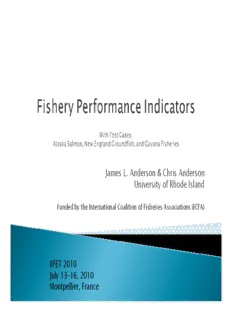
James L. Anderson & Chris Anderson University of Rhode - Allfish PDF
Preview James L. Anderson & Chris Anderson University of Rhode - Allfish
James L. Anderson & Chris Anderson University of Rhode Island Funded by the International Coalition of Fisheries Associations (ICFA) IIFET 2010 July 13-16, 2010 Montpellier, France Some Guiding Principles COMMERCIAL FISHING is a BUSINESS and (cid:1) should create wealth Ecological sustainability is NECESSARY, but (cid:1) NOT SUFFICIENT, for commercial fisheries to generate sustainable income and create wealth Community sustainability is necessary for (cid:1) sustainable wealth creation. A wealth-based fishery management system (cid:1) is one that is ecologically sustainable, socially acceptable and generates sustainable resource rents or profits. Purpose: The Fishery Performance Indicators (cid:1) (FPIs) are designed to evaluate and compare the world’s fisheries management systems based on their ability to generate sustainable wealth Given the substantial cost of many certification (cid:1) programs they are inherently biased toward rich nations. Yet much of seafood trade flows from the poor and (cid:1) underdeveloped to the rich The emphasis is on biological and ecosystem (cid:1) indicators and regulatory compliance does not address the essential objective of managing commercial fisheries—to create sustainable income and wealth An Example: The management of the MSC Certified Alaska salmon fishery imposes significant costs and hampers innovation, quality, and marketing. Alaska’s Bristol Bay drift gillnet salmon fishery -2005. (Photograph by Bart Eaton, Source: Gunnar Knapp) 5 (cid:1) Better and more consistent quality is essential for improving markets (cid:1) Fundamental changes in management and fishing practices are needed Alaska Sockeye salmon 2006 – Photo: M. Gleason Sockeye salmon in a Bristol Bay gillnet at low tide – Source G. Knapp 6 – The state mandates the use of inefficient boats and gear – The current management system forces fishermen to race for fish – The current management system discourages investment in processing and marketing. Knapp, G. “Challenges and Strategies for the Alaska Salmon Industries.” 2002. ISER, University of Alaska, Anchorage Globally the cumulative economic loss over the past three decades ranges around $$$$UUUUSSSS 2222 ttttrrrriiiilllllllliiiioooonnnn The Sunken Billions: The Economic Justification for Fisheries Reform.Agriculture and Rural Development, The World Bank, Washington, DC, 2008 Greater attention must be focused on (cid:1) governance systems and economic factors It is not good enough to be just biologically (cid:1) sustainable; fisheries and the communities that dependent on them must generate sustainable wealth. The creation of a Wealth-Based Fisheries Performance Indicators give stakeholders who are rely on fisheries for their livelihood critical information to make the case for better fisheries management based on a broader set of criteria incorporating governance and economic factors
Description: